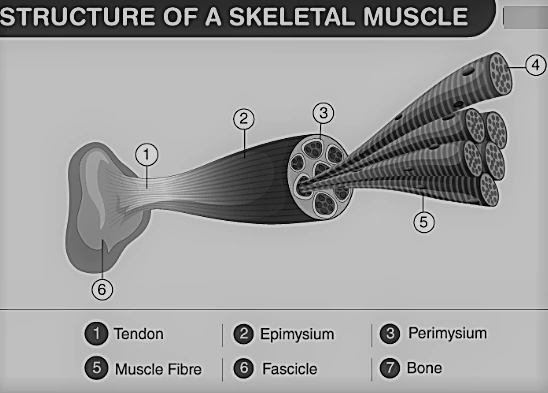Skeletal Muscles
Skeletal Muscles
In the human body, skeletal muscle is one of the three types of muscles. The other muscles are visceral and cardiac. In this chapter, we will concentrate on skeletal muscles, including the skeletal muscles functions, and skeletal muscles structure.
What is Skeletal Muscle?
Skeletal muscle happens to be a muscle tissue which is attached to the bones. It is involved in the functioning of different parts of the body. These muscles are also known as voluntary muscles because they come under the control of the nervous system in the body.
Structure of Skeletal Muscle
The structure of skeletal muscles is shown below:

The skeletal muscle is attached to the bones by an elastic tissue or collagen fibres which are called tendons. Regarding these tendons, they are comprised of connective tissues. There is a bundle of muscle fibres which are called fascicule. These fascicules happen to be cylindrical in shape, as shown in the figure. Blood vessels and other layers of tissues surround these muscle fibres.
There is a plasma membrane which is known as sarcolemma reticulum, which is found in each muscle fibre. It encloses a cytoplasm called sarcoplasm which has the endoplasmic reticulum. Coming to the muscle fibres, it consists of myofibrils. It has two important proteins, which are actin and myosin. The fascicule is enclosed by perimysium, whereas the endomysium is the connective tissue that encloses the muscle fibres.
Types of Skeletal Muscle
There are two types of skeletal muscles which have been discussed below:
Red Muscles:
Red muscles are due to the red pigment, which is called myoglobin. It consists of high amounts in the human body. Regarding the size, these muscles appear to be smaller in diameter. They have a large number of mitochondria in it. Oxygen is stored by the myoglobin, which is used by the mitochondria for the synthesis of ATP. There is a large number of blood capillaries in red muscles.
White Muscles:
Unlike the red muscles, the white muscles appear to be bigger in diameter and have a small amount of myoglobin in it. They also have less number of mitochondria in it.
Functions of Skeletal Muscle
Let us have a good look at the functions of skeletal muscle function:
- The skeletal muscles help in the body movements like breathing, extending the arm, typing, writing, etc. Here the muscles contract where tendons are pulled on the bones and causes movement.
- The skeletal muscles maintain body posture. The gluteal muscle is mainly responsible for the erect posture of the body. In the case of body movement, sartorius muscles in thighs are responsible.
- The skeletal muscles help in protecting the internal organs and tissues from any injury. It also provides support to these delicate organs and tissues.
- The skeletal muscles also help to support the entry and exit points of the body. Around the mouth, anus and the urinary tract, the sphincter muscles are present.
- These muscles contract which leads to reduction in the size of the openings. It also facilitates food swallowing, defecation, and urination.
- The skeletal muscles also make it possible in regulating body temperature. You always feel that your body gets hot after a strenuous exercise. This is because of the contraction of skeletal muscles which converts energy into heat.
Related Videos:
- Joints
- Human Skeletal System
- Synovial Joints
- Mechanism of Muscle Contraction
- Actin is present in thin filament
- Human skeleton has 206 bones
Features of Smooth Muscle
We will now try to understand the features of smooth muscles which are as follows:
- Smooth muscle is that type of muscle tissue where different systems for the application of pressure to organs and vessels is utilized. It proves to be an involuntary muscle, where it does not show any cross stripes even when it is examined under a microscope.
- A smooth muscle comprises of cells which are found to be narrow and spindle-shaped with a single nucleus that is centrally located.
- The cells of smooth muscles comprise fibres of myosin and actin. It runs through the cells and is also backed by a framework of various proteins. Here, the filaments are arranged in a stacked pattern across the cell.
- Smooth muscles also exhibit a ‘staircase’ arrangement of the fibres-actin and myosin. This happens to be typically different from the structure, which is observed in skeletal and cardiac muscles.
- Unlike the striated muscles, the smooth muscle tissues make it possible in contracting at a slower pace automatically. It is important to note that most of the musculature of the digestive system and the internal organs comprise of the smooth muscles.
Features of Cardiac Muscle
- The cardiac muscle is one of the three types of muscles in our body. It is a muscle tissue which is found in the heart.
- It performs and also brings about coordinated contractions that enable the heart in pumping blood throughout the body through the circulatory system.
- The cardiac muscle helps in the continuous pumping of the heart through involuntary movements. This happens to be one of the striking features of cardiac muscles that set it apart from the muscle tissues. This is possible due to the specialized cells which are known as the pacemaker cells.
- It helps in governing the contractions of the heart.
The cardiac muscles are composed of the following:
- Gap junctions
- Desmosomes
- Nucleus
- Intercalated discs
So, in this chapter, we have discussed skeletal muscles where we have also learnt the functions and structures of the skeletal muscles.
Important Chapters:

Similar Questions
Knowledge Check
- Question 1 - Select One
Skeletal muscle fibre is a "Syncytium" which means it is
AMade up of many fibresBMade up of many proteinsCLong and slendarDMultinucleated. - Question 2 - Select One
A skeletal muscle can show
Aisotonic contractionBisometric contractionCtwitch contractionDAll of the above - Question 3 - Select One
Contraction period for a skeletal muscle is
A4 secB0⋅04 secC0⋅02 secD20 sec.

